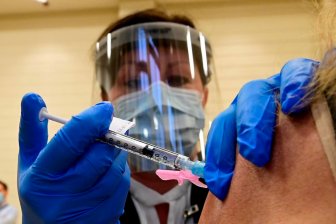Health
COVID-19 free: How have so many people escaped the virus? Here’s what we know – Global News
More than two years into the pandemic, many in Canada and around the world have remained COVID-19 free – or at least, have not tested positive for it.
In Canada, nearly 3.5 million coronavirus cases have been reported, which is nine per cent of the total population — but what about the rest?
Experts say due diligence with public health measures, the power of vaccination and a little luck have kept many COVID-19 free.
“To not get COVID, you have to be careful, meticulously careful and also fortunate,” said Colin Furness, infection control epidemiologist and assistant professor at the University of Toronto.
Your location and living arrangement can increase the likelihood of catching COVID-19, with studies showing that marginalized communities are at greater risk of infection.

Genetic factors, that have not yet been identified, could also be playing a role with some people being simply impervious to COVID-19, said Furness.
That can also explain why people have different reactions to the virus and experience varying symptoms.
International researchers are trying to determine which genes are potentially resistant to SARS-CoV-2, the virus that causes COVID-19.
“There are some diseases that are clearly linked to one gene, but in many cases, it’s far more complicated and there might be multiple pathways,” said Furness.
There are seven known coronaviruses that can infect humans, including the common cold.

Previous exposure to other forms of coronaviruses can keep someone from catching COVID-19, said Dr. Horacio Bach, an infectious diseases expert at the University of British Columbia.
“These people develop antibodies, so when they are theoretically exposed to the virus, they can get rid of it very easily because of what we call cross-reaction,” Bach explained.
A study published in the Nature Communications in January suggested that having higher levels of pre-existing T cells that are created by the body when infected with other coronaviruses, can protect someone against COVID-19 infection.
Another study published in November 2021 in the scientific journal Nature also showed that health-care workers in the United Kingdom who repeatedly tested negative for COVID-19 were able to fend off the virus because of the presence of T cells from exposure to previous seasonal coronaviruses.

Because much of the research for COVID-19 has been focused on those infected and how to treat them, experts say it is hard to exactly pinpoint why certain people have managed to evade the virus so far.
Getting to the bottom of this question could be a “real game-changer” in fighting the pandemic, said Furness.
“It’s possible that if we could figure out on what basis some people are immune, we might be able to develop effective drugs. We also might be able to just identify who’s at high risk.”
© 2022 Global News, a division of Corus Entertainment Inc.
Health
Whooping cough cases up slightly in N.L., as officials warn about risks to infants – CBC.ca

Newfoundland and Labrador’s top doctor is warning people to stay up to date on whooping cough vaccinations after a small increase in cases this year.
The province usually sees three to four cases of the disease annually. Up to 10 cases have been reported already since January, however, prompting the province’s chief medical officer to raise the issue publicly.
The increase “generally means there’s a little bit more circulating in the community than what’s presenting for care and testing,” Dr. Janice Fitzgerald said Tuesday.
While officials aren’t overly concerned about a future spike in cases, Fitzgerald said, higher infection rates place infants in particular at risk.
Children under the age of one aren’t yet old enough for the whooping cough vaccine and don’t have immunity to the disease, Fitzgerald said. Infections in small children can be more severe and lead to pneumonia, neurological issues and hospitalization.
Fitzgerald said parents, grandparents and caregivers should check to ensure their vaccinations are up to date.
Whooping cough, also known as pertussis, causes a persistent nagging cough that’s sometimes severe enough to cause vomiting. Vaccines for the disease are offered in early childhood, during high school and in adulthood. Booster shots should be given 10 years after the high school dose, Fitzgerald said.
“Immunity can wane over time,” she said. “Pertussis does circulate on a regular basis in our community.”
The small increase in cases isn’t yet ringing alarm bells for undervaccination within the general population, she added, noting the province still has a vaccination rate over 90 per cent.
Download our free CBC News app to sign up for push alerts for CBC Newfoundland and Labrador. Click here to visit our landing page.
Health
Supervised consumption sites urgently needed, says study – Sudbury.com

A study in the Canadian Medical Association Journal (CMAJ) said the opioid drug crisis has reached such a critical level that a public safety response is urgently required and that includes the need for expanded supervised consumption sites.
The report was published by the medical journal Monday and was authored by Shaleesa Ledlie, David N. Juurlink, Mina Tadrous, Muhammad Mamdani, J. Michael Paterson and Tara Gomes; physicians and scientists associated with the University of Toronto, Sunnybrook Research Institute and the Li Ka Shing Knowledge Institute at St. Michael’s Hospital.
“The drug toxicity crisis continues to accelerate across Canada, with rapid increases in opioid-related harms following the onset of the COVID-19 pandemic,” the authors wrote. “We sought to describe trends in the burden of opioid-related deaths across Canada throughout the pandemic, comparing these trends by province or territory, age and sex.”
The study determined that across Canada, the burden of premature opioid-related deaths doubled between 2019 and 2021, representing more than one-quarter of deaths among younger adults. The disproportionate loss of life in this demographic group highlights the critical need for targeted prevention efforts, said the study.
The researchers found that the death rate increased significantly as fentanyl was introduced to the mix of street drugs that individuals were using, in some cases, unknowingly.
The authors said this demonstrates the need for consumption sites, not only as overwatch as people with addictions consume their drugs, but also to make an effort to identify the substances and inform those people beforehand.
“The increased detection of fentanyl in opioid-related deaths in Canada highlights the need for expansion of harm-reduction programs, including improved access to drug-checking services, supervised consumption sites, and treatment for substance use disorders,” the authors wrote.
The study said a more intense public safety response is needed.
“Given the rapidly evolving nature of the drug toxicity crisis, a public safety response is urgently required and may include continued funding of safer opioid supply programs that were expanded beginning in March 2020, improved flexibility in take-home doses of opioid agonist treatment, and enhanced training for health care workers, harm reduction workers, and people who use drugs on appropriate responses to opioid toxicities involving polysubstance use.
In conclusion, the authors wrote that during the height of the COVID pandemic in 2020 and 2021, the burden of premature death from accidental opioid toxicities in Canada dramatically increased, especially in Alberta, Saskatchewan, and Manitoba.
“In 2021, more than 70 per cent of opioid-related deaths occurred among males and about 30 per cent occurred among people aged 30–39 years, representing one in every four deaths in this age group. The disproportionate rates of opioid-related deaths observed in these demographic groups highlight the critical need for the expansion of targeted harm reduction–based policies and programs across Canada,” said the study.
The full text of the report can be found online here.
Health
Business Plan Approved for Cancer Centre at NRGH – My Cowichan Valley Now


A business plan for a new BC Cancer Centre at Nanaimo Regional General Hospital has been approved by the province.
Health Minister Adrian Dix says the state-of-the-art cancer facility will benefit patients in Nanaimo and the surrounding region through the latest medical technology.
The facility will have 12 exam rooms, four consultation rooms and space for medical physicists and radiation therapists, medical imaging and radiation treatment of cancer patients.
The procurement process is underway, and construction is expected to begin in 2025 and be complete in 2028.
Upgrades to NRGH have also been approved, such as a new single-storey addition to the ambulatory care building and expanded pharmacy.
Dix says Nanaimo’s population is growing rapidly and aging, and stronger health services in the region, so people get the health care they need closer to home.
-



 Tech22 hours ago
Tech22 hours agoiPhone 15 Pro Desperado Mafia model launched at over ₹6.5 lakh- All details about this luxury iPhone from Caviar – HT Tech
-



 Sports22 hours ago
Sports22 hours agoLululemon unveils Canada's official Olympic kit for the Paris games – National Post
-
News20 hours ago
Toronto airport gold heist: Police announce nine arrests – CP24
-
Media24 hours ago
NPR's liberal bias: Editor exposes media's lack of viewpoint diversity – USA TODAY
-
News16 hours ago
Loblaws Canada groceries: Shoppers slam store for green onions with roots chopped off — 'I wouldn't buy those' – Yahoo News Canada
-



 Tech20 hours ago
Tech20 hours agoVenerable Video App Plex Emerges As FAST Favorite – Forbes
-
Investment15 hours ago
Saudi Arabia Highlights Investment Initiatives in Tourism at International Hospitality Investment Forum
-
Art16 hours ago
Squatters at Gordon Ramsay's Pub Have 'Left the Building' After Turning It Into an Art Café – PEOPLE







